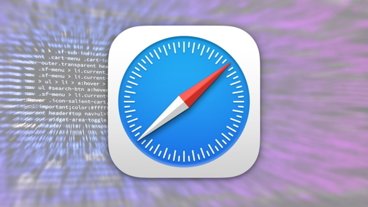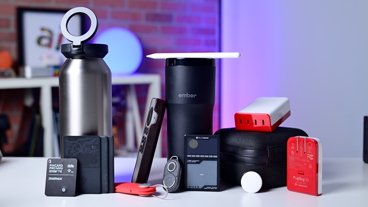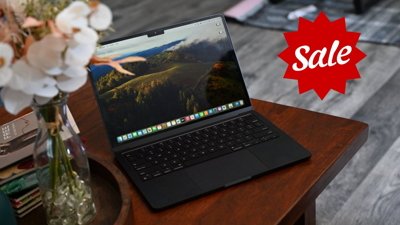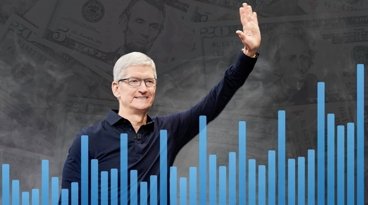Even though the saga started after the fiscal quarter ended, Apple's Q2 financial results are going to be profoundly different thanks to the Trump tariffs. Here's what to expect from the results on May 1.
As regular as clockwork, Apple will be reporting its Q2 2025 earnings on May 1, with the results released ahead of the standard analyst and investor conference call at 5p.m. Eastern.
Apple's CEO Tim Cook will be on the call, along with newly-installed CFO Kevan Parekh, to discuss the results and to take on questions from analysts.
Given the turbulent April Apple endured thanks to the introduction of tariffs against China and the rest of the world by President Donald Trump, Cook and Parekh will probably have a lot more questions about the supply chain than normal.
Last quarter: Q1 2025 details
The Q1 results saw Apple report its highest figures for the year, including revenue growing year-on-year to $124.3 billion from $119.58 billion in the year-ago quarter.
On a unit basis, iPhone was relatively flat year-on-year at $69.1 billion for the quarter, iPad rose from $7.02 billion to $8.088 billion, and Mac rose from $7.78 billion to $8.99 billion. Wearables, Home, and Accessories saw a small dip from $11.95 billion to $11.747 billion.
Services continued its growth streak, from $23.12 billion in Q1 2024 to $26.34 billion in Q1 2025.
That quarter had a lot of preceding launches, including the iPhone 16 range, USB-C on AirPods Max, the Apple Watch Series 10, and the Black Apple Watch Ultra.
Apple's board of directors declared a cash dividend of $0.25 per share of common stock. The Earnings Per Share was listed at $2.41.
On a regional basis, which is quite pertinent this time around, Greater China revenue saw a YoY dip from $20.8 billion to $18.513 billion.
Year-ago quarter: Q2 2024
Typically the benchmark for comparison for the current quarter's results, the Q2 2024 results were a bit of a dip for the company. Overall revenue of $90.75 billion was down from the previous Q2 2023's figure of $94.8 billion.
Even so, there were quite a few positives. For a start, Apple beat Wall Street, with its consensus putting Apple's revenue at somewhere between $82.32 billion and $86.15 billion.
Apple's EPS of $1.53 was up year-on-year from $1.52, and also beat Wall Street's forecast of $1.50.
That quarter had relatively few product launches, including the release of the Apple Vision Pro, as well as M3 Apple Silicon updates to the MacBook Air range.
Revenue from iPhone was $45.96 billion, down YoY from $51.3 billion. Mac was flat, from $7.45 billion one year prior to $7.2 billion.
There was a dip for iPad from $6.7 billion to $5.56 billion, while Wearables, Home, and Accessories shifted downward from $8.76 billion to $7.9 billion. Services kept up its growth trend, going from $20.9 billion in Q2 2023 to $23.9 billion in Q2 2024.
What happened in Q2 2025
As usual for the period, Apple had some product launches, including the iPhone 16e, the 11th-gen iPad, the M3 editions of iPad Air, the M4 MacBook Air, and an updated Mac Studio.
While it won't have the same impact as in the massive Q1 results, there will still be the lingering effects of product launches from the end of 2024, including the iPhone 16 generation, a new iPad mini, and the November Mac launches.
These will have a material impact on revenue in the Q2 results.
Post-quarter Trump tariffs
A current hot-button issue that will be raised during the analyst conference call, and that Apple will probably advise on, is the state of tariffs. After the quarter ended, the Trump administration decided to issue "reciprocal tariffs" against each country in the world.
Given the volatile nature of the situation, it is almost certain that the tariffs, and what Apple can do to mitigate their effects on the supply chain as a whole, will dominate the analyst chatter.
The tariffs were heralded very early in Apple's second quarter, but were not implemented until April, after the quarter ended. The tariffs won't impact the results of the quarter itself, but will almost certainly play a factor in Q3 and future quarter discussions.
The tariff fight included a period of tit-for-tat rises, with Trump setting a high rate for China, then China fighting back with its own on imports from the U.S., followed by a response by Trump.
The affair severely impacted Apple's stock price, with investors worried about the potential high price rises of Apple goods in the United States, caused by the tariffs.
Eventually, Apple and other tech companies were given some respite in the form of an exception. This is, however, temporary until new "semiconductor tariffs" arrive in the future.
China, meanwhile, was fed up of raising its tariff against U.S. goods, and went a different route. Instead, it ceased the exports of rare earth minerals and magnets, which can impact supply chains around the world.
While investors may be worried about future iPhone pricing, it probably won't affect sales that much. Analyst research has determined that the intention to upgrade in the next 12 months is at an all-time high.
However, that survey occurred in March, before the tariffs hit the world. Consumer opinion may have changed a lot since then.
Wall Street Consensus
The Wall Street consensus refers to a survey of analysts. The results are averaged out to give a general opinion of where investors and analysts are leaning in their quarterly forecasts for Apple.
Yahoo Finance
In the estimates published by Yahoo Finance as of April 29, 27 analysts offered an average revenue estimate of $94.42 billion. The estimated range goes from a high of $96.33 billion to a low of $90.06 billion.
For the earnings per share, a group of 28 forecasts an average of $1.61, with a high of $1.66 and a low of $1.53.
TipRanks
On April 30, TipRanks offered its own consensus figures. The revenue forecast is at $94.25 billion, with a range from $89.4 billion to $96.33 billion.The earnings per share is expected to be $1.62, with a range from $1.47 to $1.67.
Analyst Expectations
As Apple's results get closer to release, analysts offer what they believe will be included in the issued figures, and where Apple's future could lead for the coming year.
Bank of America
In an update reported on April 29, Bank of America reiterated a "Buy" rating for Apple. However, it also lowered the price target for the shares, from $250 to $240.
Analysts cited uncertainty in the economic outlook, but still believed there would be some near-term upside for the quarter. Pull-forward of demand from tariff concerns is a bright point, but that could die down as economic worries become more of an issue for consumers as the months roll on.
Evercore
On April 28, Evercore ISI's note to investors previewed the quarter, insisting that Apple has a host of mitigation strategies to offset the impact of tariffs over time. While Apple is not expected to offer guidance beyond Q3, or to take a stance on where tariff rates will settle for the long term, Evercore still expects a Q3 guidance to be issued.
Currently, the Q3 gross margins are expected to be guided down 50 to 100 basis points quarter-on-quarter, slightly below the 40 basis points of its consensus. The Q3 margin estimate is expected to be 46% down 100 basis points quarter-to-quarter or down 30 basis points year-on-year.
Overall, Evercore maintained its "Outperform" rating for the stock, with a price target of $250.
JP Morgan
In an April 28 note to investors, JP Morgan analysts were feeling positive about AAPL, both for Q2 and Q3.
For Q2, the revenue estimate was raised from $93.5 billion to $95.8 billion, while the earnings per share was upped from $1.59 to $1.66. The reasoning was a pull-forward of demand for Apple products due to the early-year threat of tariffs prompting earlier consumer upgrades, as well as for retailers to boost their inventories.
The logic continues with the Q3, which JP Morgan believes is "better than feared" at $90.8 billion revenue, $1.51 EPS. The uncertainty of the tariff situation should equate to more pull-forward and higher sales, especially due to seeing the early effects of tariff decisions.
At the time, JP Morgan maintained its "Overweight" rating and a $245 price target.
Morgan Stanley
In an April 28 note to investors, Morgan Stanley forecast that Apple should modestly exceed the consensus in Q2, but the tariff backdrop introduces some downsides to Q3.
For the Q2 results, the forecast is $95.7 billion and an EPS of $1.64. Product pull-forward will have been strong because of the tariffs, as well as benefiting from a weaker dollar overall. Services is expected to grow 12% year-on-year.
When it comes to Q3, Morgan Stanley too thinks that it will be a better-than-feared situation. Its model for the June quarter is for the "volatile" U.S. tariff policy to rest at a 20% tariff for all exempted products manufactured in China, which would affect iPhone, iPad, and Mac, and a 145% rate on Chinese AirPods, versus 10% for Vietnam-produced AirPods.
Morgan Stanley considers Apple's stock to be "Overweight" with a price target of $235, up from $220.
Goldman Sachs
On April 23, Goldman Sachs lowered its price target from $259 to $256. It still maintained a "Buy" rating on the shares, despite the target cut.
Goldman Sachs believes Apple should offer strong results thanks to new product innovation and channel fill, as well as a pull-forward caused by the tariff situation. Competitiveness between US carriers and good Services performance also stands to help Apple in the quarter.
UBS
On April 23, UBS slashed its stock price target for Apple from $236 down to $210. Despite the pessimism, UBS maintains a "Neutral" rating for Apple.
The change was based on expected changes to tariffs, but the pessimistic viewpoint is still accompanied by hope for growth. A pull-forward in iPhone shipments may have increased growth by about 1 million units in the quarter, even though demand was apparently pretty flat.
For the quarter, the overall revenue forecast was increased by 2% to $95.5 billion, from $93.5 billion previously. The EPS has also been increased in estimates, from $1.56 to $1.62.
Wedbush
On April 13th, Wedbush lowered its full-year earnings per share estimates for Apple, from $7.44 per share for the year to $7 flat. Wedbush's consensus estimate puts Apple at $7.28 for the full-year earnings
Wedbush holds an "Outperform" rating for Apple, with a $250 price target.
 Malcolm Owen
Malcolm Owen



-m.jpg)





-m.jpg)






 Christine McKee
Christine McKee
 Charles Martin
Charles Martin


 William Gallagher
William Gallagher

 Marko Zivkovic
Marko Zivkovic








12 Comments
I think it will all be about JuneQ guidance which with the dollar falling off a cliff, iPhone panic buying and stock price favorabiliy buyback ramp ups should be pretty strong.
Headwinds. Headwinds. I wonder if there is an over/under in Vegas for how many times they'll say it. Lol
I'm guessing dividend will get increased by a penny and earnings will be about what analysts thought this quarter (with best uptick on computers).
Bring on the haziest call in ages.
I am trying to imagine the response if Apple's profit had dropped by 71% and Tim Cook got on the call to say he was going to cut back his extracurricular activities that were alienating Apple's customer base to only two days a week. I mean, Chief Executive Officer is a part-time job, right?